

Click here to view Brinkman Appeal in full.
On the 25th Feb 2002 we discovered the buried Brinkman decision. we then forwarded this to Hereford planning with the request for enforcement the removal of polytunnels 26th Feb 2002
From this decision without a shadow of doubt:
polytunnels
do need planning permission.
they
cannot be regarded as temporary structures.
they do
not constitute permitted development for agricultural purposes.
Furthermore we asked the council:
if not,
why not?
if the
council knew and did not act, why?
The appeal relates to 6
hectares of strawberries being grown in Spanish tunnels
*The Councils decision to take
enforcement action was fully justified to protect the landscape within the AONB
A comparison of
sites between Bosham, Chichester
and Kings Caple and Walford, Herefordshire
All sites are within an AONB
AONB’s share equal status
with National Parks in terms of scenic beauty and landscape protection “
Kings Caple total of land covered with ground
polythene is 29.27 Hectares/ 72acres
The current area with polytunnels is 14.5 hectares.
Bosham
Chichester site was 6 hectares judged detrimental to the AONB
Kings Caple is already TWO AND A HALF times the size of Chichester
When the 72 acres are covered with tunnels it will be FIVE times larger
Bosham was in flat landscape Kings
Caple
is in undulating valley
In the village of Hoarwithy many
of the houses look directly on to and over these tunnels. There is no doubt that this has
destroyed the views for the many who considered this aspect to be the crucial factor of
why they chose to live in an AONB. (There is continuous burning and footpaths diverted
around plastic) Because of undulating landscape the site is prominent and can be seen
miles away
Walford 150 acres site, TEN` TIMES LARGER than
Chichester is also expanding. A major blight off the A 40 Ross to Monmouth. The Spires of
St Mary’s’, Ross on Wye now dominated by fields of plastic, other tourist sites,
one & half miles to the south lies Goodrich Castle, Chase Wood. to the east, Symonds
Yat four miles, A continuous blight throughout the year, year upon year, development
against the ethos of the AONB. Hereford planning would have you believe these polytunnels
are “temporary” they are not.
.In connection with Brinkman appeal, letters had been submitted from South Herefordshire District Council. It is reasonable to assume that the council was fully informed of the outcome of this ruling, if not then by magazine, periodical and circular. Despite enquiries by individual’s, Parish Councils and others, notably Paul Keetch M.P. Hereford Council appear to have withheld this information and decided not to enforce this planning appeal decision.
If the council had enforced this appeal decision one of the most beautiful sites in the wye valley would not have been destroyed by this dreadful blight (Pennoxstone Kings Caple). Apparently the authorities at Chichester have a greater appreciation of their landscape and the willingness to take action to conserve. Herefordshire Council even when court rulings exists have not used it to protect our finest landscapes.
We were unaware that Hereford council were concealing the Brinkman decision and believed that they had indeed had no legal means by which to control polytunnels
Copy end of file
Six months earlier Hereford planning had been informed that there was indeed a way forward to control polytunnels due to the case of” Skerrits of Nottingham Ltd v. Secretary of State for the Environment” March 22 2000. This case overturns previous laws on the subject of “temporary” structures and, on the face of it, was the blue print for introducing controls over polytunnels
The
important aspect of this case is that it underpins the arguements used in the Brinkman
decision.
Brinkman Brothers were to lodge a further appeal against the Chichester decision, however
they abandoned this due to the Skerrit ruling.
To support our case we provided copy of correspondence with the council, twenty two letters over a period of four years
15th March 1999 letter from
5th May 1999, letter from L.Hill, Assistant Enforcement Officer “Polythene Tunnels at Pennoxstone Kings Caple Herefordshire”
14th May 1999, letter from
5th Dec 2000 from
“Past case law has considered the “temporary “ nature of polytunnels. The
manner of their affixation to the ground has proved a determining factor."
There is no reference to Brinkman ruling.
6th Dec 2000 from
“Responses to polytunnels are essentially subjective....If however the regulations
were to be changed I would suggest that an intervention was confined to substantial
tunnels –e.g. of greater than 2m high and fully enclosed”. The impracticality of
this proposal can be discussed. The more serious matter is;
Paul Keetch MP had rasied this issue with Ian Slater. Ian Slater had the legal resources
of Herefordshire Council at his disposal yet there is no reference to the Brinkman Ruling.
The concern of our MP is met with discmissive response, to object o fifty acres / forty
miles end to end of polytunnel in an AONB is to be "essentially subjective".
Whilst it is appreciated
at least a degree of involvement, how does this proposal of regulating the height of a
tunnel work, 2m high or 2.4m high it matters little in undulating landscape? This is not
Norfolk”.
Escaping planning consents means that there is no platform to challenge flippant remark
and half baked notions.
12th April 2000 from
Polythene Tunnels at Pennoxstone Kings Caple Herefordshire
Further to your letter of 28th March I confirm that-
Herefordshire Council Planning Authority is not seeking to gain any such powers as the
current controls are as laid down within the Town and Country Planning act 1991(as
amended). It would be a matter for central government to undertake any revision of the
Act.
Herefordshire Council did have Powers
Not only with reference to Brinkman but also to Skerrits case law (Skerrits of Nottingham
Ltd v. Secretary of State for the Environment” March 22nd 2000 which overturns
previous interpretations on the subject of “temporary” structures).
8th May 1999 and 28th June 1999, letters from Gareth Key, Technical Officer Pollution, Environment Health, Herefordshire Council
18th Feb 2000, letter from
25th Feb 2000,
4th July 2001 (and subsequent visit in October 2001)
Enforcement was not forthcoming and after 28 days we took our complaint to the Ombudsman.
An important aspect of the Brinkman decision is that the site is
within an AONB.
It is reasonable to assume that AONB Offices talk to each other particularly on such an
important issue.
If the AONB had operated and enforced this appeal decision, one of
the most beautiful sites in the Wye Valley would not have been destroyed by this dreadful
blight, nor would we have had to watch and stand helpless, whilst our houses were
surrounded and our landscape lost.
We drew attention to the long record of correspondence sent over a period of two years without acknowledgement or response in which video newspaper articles Parish council resolution and other documentation were enclosed.
7th March, Eventually we received a letter from Andrew
Blake
“I was Aware in
1998 of a forth coming Public Inquiry in Chichester”
He had never pursued to know the outcome
The use of polytunnels is hardly appropriate in the undulating landscape of the Wye Valley AONB and in the most sensitive area alongside the main geographical feature the river Wye itself, in open valley.
It is hard to believe this did not happen.
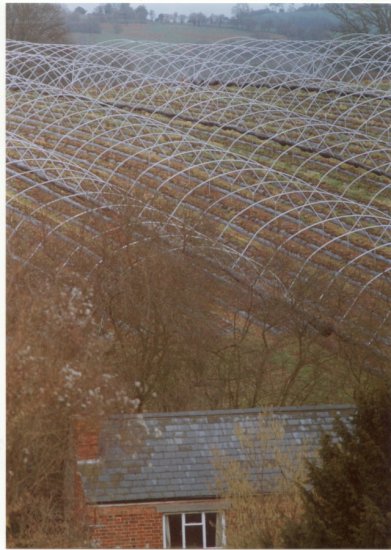
Extracts
from
OUTLINE
OF THE WYE VALLEY AONB & WYE VALLEY (ENGLAND & WALES)
Areas
of Outstanding Natural Beauty share equal status with National Parks in terms of scenic
beauty and landscape protection.
It is in the nation’s interest to safeguard them for the future generations through a
unique legal status, which can;
a. Stimulate special policies for controlling development
b. Encourage appropriate land management
The council have failed to implement legal ruling and have allowed polytunnels in the
AONB”. Plastic sheet/ tunnel is seen as legitimate farming practice
There have been no special policies, indeed it has been worse, the council have failed to
implement even the most rudimentary controls.
There has been no appropriate land management.
The
primary purpose of AONB designation is to conserve and enhance natural beauty
Particular
regard should be paid to promoting sustainable forms and economic development that in
themselves conserve and enhance the environment.
Hereford council’s policy of “no planning consents required” means
theoretically that all of the AONB its 326 sq km could be covered with plastic
The
objectives are;
To
protect conserve and enhance the natural beauty and amenity of the Wye Valley, including
its physical, ecological and cultural landscape.
Development
on vast scale is in the heart of the Wye Valley AONB, at Kings Caple alongside the main
geographical feature in Herefordshire the river itself, in open valley and amidst
historical buildings, the most sensitive location in an area of great landscape value,
site of special scientific interest.
Previously Kings Caple, Hoarwithy and Sellack Churches, monuments to our cultural and
historic past, once shone as beacons on the horizon; now this splendid panorama is
desecrated, dominated with hideous polytunnels (see aerial photos) Neil Cockburn Says in
his opinion these are not an eyesore, nevertheless he has not a single polytunnel or sheet
of plastic in front of his own home Pennoxstone Court. He surrounds other peoples houses
and destroys the main attribute for living here, the visual beauty.
To
promote the quiet informal enjoyment of the Wye Valley by the general public but only so
far as is consistent with the first objective
There has been a long history of complaints to the Environmental Health with regard to the
noise of irrigation pumps. As more tunnels are erected the crop deprived of rainfall has
to be increasingly irrigated from the depleted River Wye resource
What effect the considerable rainwater “RUN OFF” is having both on the raising
of the flood level and the erosive aspects on the flood plains has not been researched. I
have asked for a response from the council because this issue has been raised a number of
times at various meetings.
To my knowledge no visit or discussion has ever taken place with these growers.
The AONB Officer has said he is to talk with Mr Drummond in June 2002
This is six months after our formal request for enforcement at Kings Caple
Clearly
many farmers need to diversify if they are to make a living but this is not traditional
pattern of fruit orchards or strawberries under straw, essential to landscape value nor is
it farming in any previous convention of the word this is third world factory enterprise
in the midst of the most glorious English landscape.
I
have a letter from Sainsburys which reads “We do purchase strawberries grown in
polythene tunnels from the Wye valley,- I assure you we do pay close attention to the
environmental impact of everything we do”
a. To advise the JAC on issues affecting the AONB
b. To forge productive partnerships with those who have an impact on the environment of
the AONB
c.
To bring home to people the value of the area’s unique environment and the
significance of its AONB designation
This issue has been raised repeatedly with the AONB Office, over a period of years,
together with documentation and yet it has never been on the agenda of the Joint Advisory
Council. The only response was a telephone call following copy of Complaint to Ombudsman
being forwarded by registered post
The Wye Valley Walk is one of the regions most heavily used recreational
footpath routes.
Response
Plastic litters the fields, shinning white in winter under the retreated strawberry
plant, swathed in polytunnel the rest of the year with some respite for individual fields
when the plastic not the hoops is removed. Plastic bags lie as ballast to these frames and
plastic lies about blown by wind hanging from trees
Many of the high paths have prominent views and see this white sprawl for miles around, other paths run alongside the polytunnels. This is undesirable for those who live here and an eyesore memory for visitors.”
Footpath
Officer for Hentland
(Now
footpaths are being diverted around plastic sheet & polytunnels)
a. Proposals are for small-scale developments, which are essential to meet local needs.
Such development should be within or immediately adjacent towns and villages and of high
standards of design in sympathy with the architecture and landscape character of the area.
The
main workforce comes from eastern europe
Any financial gain is to a couple of landowners, is this local need?
Would not “green “ farming that employs more local workers be appropriate?
How is this development of benefit to the local population or the village environment?
How has this development any sympathy with the village architecture?
How is this agricultural development considered to have no adverse effects on the special
landscape character of the AONB?
Would it not be easier to move the grower out to his workforce?
Response
The natural beauty lost will ultimately mean economic suicide for tourism
Hoarwithy was such a picturesque riverside hamlet.
Once proudly featured on the cover of the Hereford Planning Booklet
Has anybody read or drawn a relationship with this report and the polytunnel development?
There
could not be a more inappropriate place to have polytunnel development
t would be permissible in a flat already degraded landscape screened by trees.
Allowing polytunnels to be placed in an undulating landscape of great beauty and value
with cultural & historical importance, a landscape truly deserving of its highest
status in Britain proves the gross stupidity of Hereford Council.
To maintain the position that these are temporary structure requiring no planning consent
in the face of legal precedent and deprive our village the right to object is against all
democratic processes.
Now
a community in Walford parish in the AONB have also made complaint to Ombudsman, also the
village of Marden
29 Sep 2000, to Paul Keetch MP from Ballingham Bolstone and
Hentland Parish Council
"We have been discussing the effects of temporary
structures in areas of outstanding natural beauty. The following resolution was made,
which I am forwarding to you for consideration....
"Structures of a temporary nature such as Poly Tunnels that do not fall
within the current constraints of planning procedures should be subject to appropriate
controls to protect sensitive areas such as 'Areas of Outstanding Natural Beauty'."
15 Jan 2001
"a). The Courts have held that some temporary structures used for agriculture are not
'buildings' in planning terms but are a use of land and so outside the general scope of
planning control. Whether particular structures such as polythene tunnels constitute uses
of land is ultimately a matter for the Courts to decide, on the facts of each case.
"b). Under the Town and Planning Order 1995, where a local planning authority believes there is a real and specific threat to the proper planning or amenities of a limited area it has powers under Article 4 of the Order to withdraw these permitted development rights.
"c). The
Countryside and Rights of Way Act 2000 includes provisions which will allow the better
management of AONB,s through the requirement for every AONB to put in place a management
plan which must be regularly reviewed. It places a duty on all public bodies and statutory
undertakers when carrying out their functions so as to affect an AONB to have regard to
the need to conserve and enhance natural beauty. It also provides for the creation of
conservation boards for individual AONB, s where there is local support for such a
move.”
27 Jan 1995, Dept of the Environment, Sir Paul
Beresford
“Whether covering land with polythene tunnels or sheeting is development requiring
planning permission is ultimately a matter for the courts and will depend on the facts of
a particular case. Paragraph B4 of Annex B to Planning Policy Guidance note 7, The
Countryside and the Rural Economy”, gives further information about temporary
structures used for agriculture,. It may be that size, permanence and the degree of
physical attachment indicate whether works amount
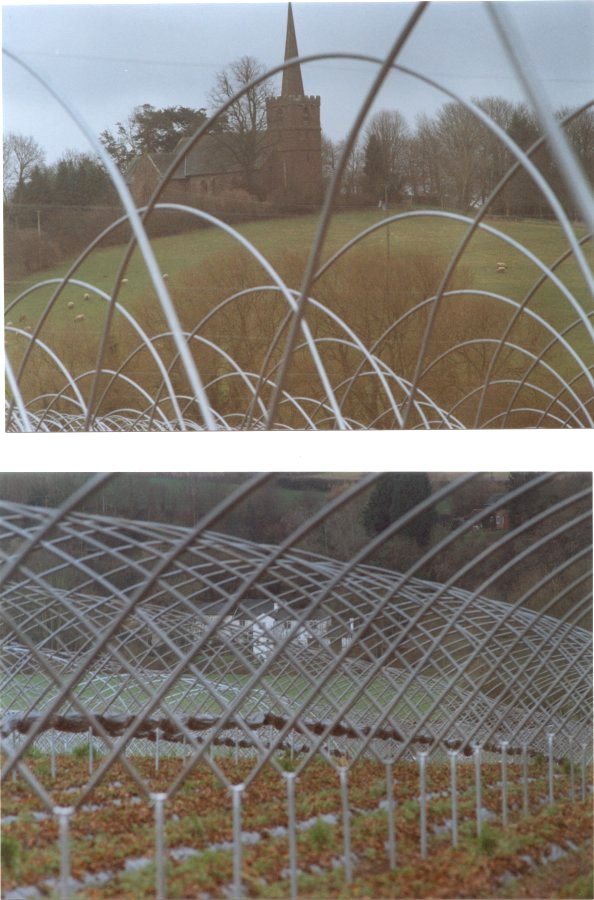
The green field is ploughed
Plastic covers the soil. This remains on the ground for the few years of the crop cycle
Gashes are made in the plastic Strawberry plants inserted
Gradually the plant grows it will not be replaced for
White plastic again litters the field as the plant recedes for winter

Hoops are raised A Construction Team working for several weeks
Plastic tunnel pulled over hoops in January
Irrigation pumps pull water from the river Mixing with chemical spray
Old plastic from other tunnels is dragged to a site and burnt
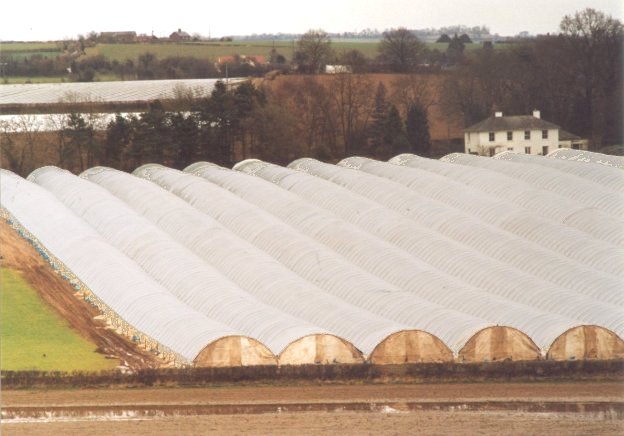
Plastic tunnel removed Hoops
remain exposed and in fixed position
Ground plastic becomes exposed as plant recedes for winter
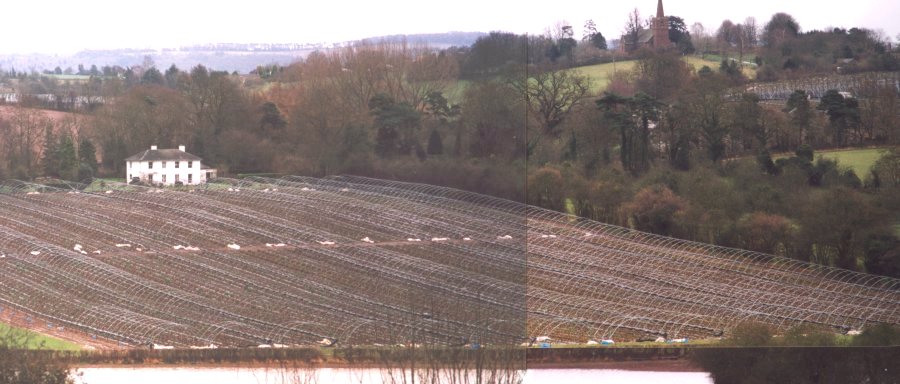
Plastic tunnel pulled over hoops in January
Irrigation pumped water from the river Mixing with chemical spray
Old plastic from other tunnels is dragged to a site and burnt
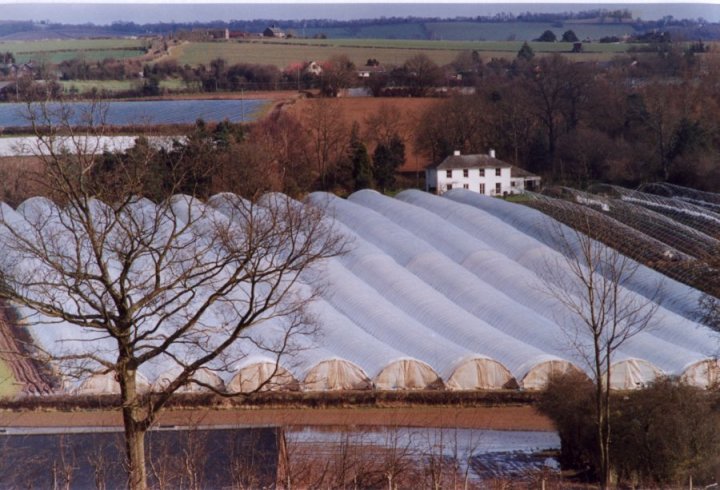
Plastic tunnel removed
Hoops remain in fixed position
Ground plastic becomes exposed as plant recedes for winter
Plastic tunnel pulled over hoops in January
Irrigation pumps pull water from the river Mixing with chemical spray
Old plastic from other tunnels is dragged to a site and burnt
Plastic tunnel whilst being removed at one site is being spread in
another
In an adjacent field new hoops and tunnels are being erected
Hoops remain in fixed position through out the years
Ground plastic becomes exposed as plant recedes for winter
In adjacent fields a different cycle is already begun or ending
The plastic /polytunnel presence is a permanent feature
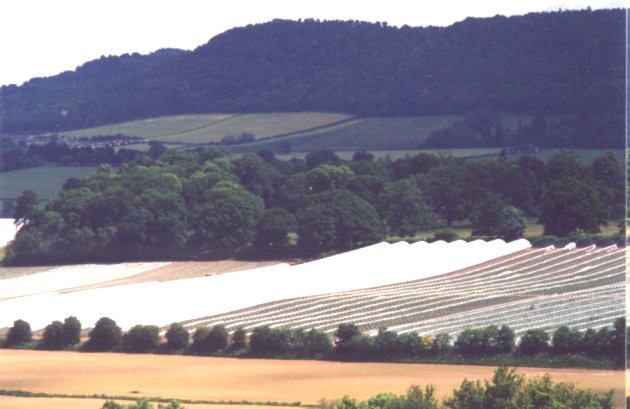
Much "nonsense" is repeatedly asserted by Hereford planning that these are
"temporary structures"
These photos at Walford graphicaly illustrate the various growing cycles and the
ever presence of the polytunnel in the landscape
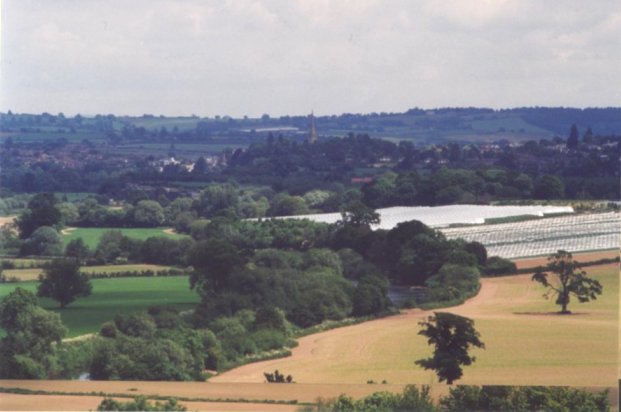
A well-established
fruit grower who has grown strawberries under straw since 1930
The main problem is the supermarket.
They demand "A" crop fruit
Under tunnels 80% of strawberries are “A” crop
Under straw 40-50% is “A” crop the rest “B”
The main problem is rain and low temperatures that produces a nose on the berry that is
unsightly, bumpier but perfectly all right to eat, the supermarkets do not like this.
Polytunnels have poor pollination so they introduce bees
The amount of pesticide sprayed in tunnels is about the same as not in tunnels.
Fungicide spray more of a problem in tunnels
Additional problems pickers from over seas
Not much profit
Hence compensation
for stopping could be reasonable
So it depends very much on supermarkets.
It is their insistence on grade “A”
Growers could sell 75% of their crop 50% as grade “A” and 25% grade
“B”
Polytunnel growers sell 80%
So an increase sale of 5% the countryside is devastated with plastic.
He knew of the Brinkman appeal
So the growers in general know one day the council and AONB will force control
The “Hundred Mile” tunnel at Walford within the AONB covers approx 150 acres
The future intension is to use different coloured breathable plastics and larger tunnels
Click to view Skerrits Case Law in full.
Click on LATEST NEWS to continue.